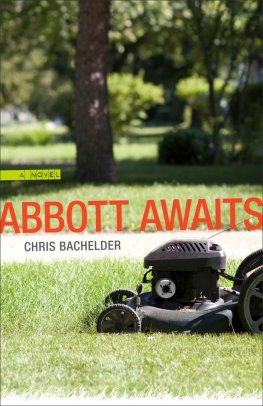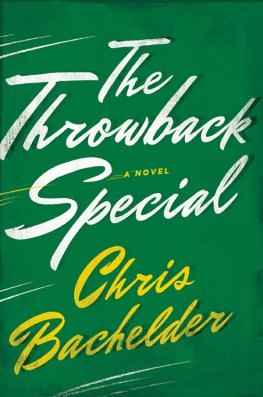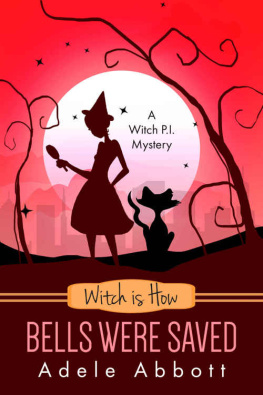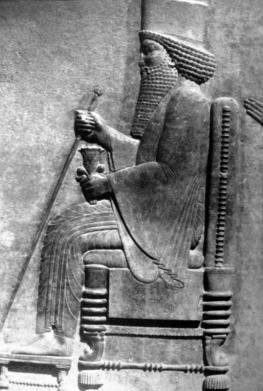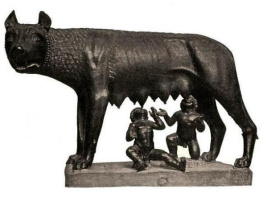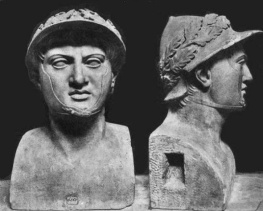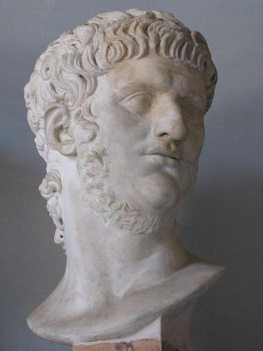Chris Bachelder
Abbott Awaits
for the wonders
Jennifer, Alice, Claire
O the evening robin, at the end of a New
England summer day! If I could ever find the
twig he sits upon!
Thoreau, Walden
The bulb in the desk lamp burned out eleven days ago, yet Abbott continues to twist the knob every time he sits down. Its habit, not hope, Abbott thinks, though he pauses over the distinction. He sits in the dark, awaiting connection. Across the hallway there is no light beneath Abbotts bedroom door, which means his wife is either asleep or not asleep. She is an insomniac, and six months pregnant. Would he wake her if New York were rubble and ash? Charlotte? But tonight the empire is more or less intact. Abbott clicks Child tied in hot car as couple dines, but he discovers that the article fails to answer the questions raised by the headline. For instance, Why do people do things? And just what is going on? Given the restaurant in whose parking lot the child, 9, was allegedly tied, the verb dines seems to Abbott not only inaccurate but editorially wicked. Elsewhere, a former celebrity has chosen death over middle age. A sleeping-bag prank has taken a life. A trap door has revealed a dungeon. In smaller type, the functioning and malfunctioning of military equipment has killed many, many people, all of whom, Abbott presumes, would rather have continued to exist, in spite of everything. Abbotts yard needs mowing, he remembers. He ought to go to bed. He knows that sleep is necessary for temperament, energy, long- and short-term memory, healthy skin, brain, heart, back, and feet. There are people who die of sleeplessness. But tonight at a righteous, low-traffic site he finds a photo essay about a Chernobyl orphanage, two decades after the Mishap. There is a warning about disturbing images. He cannot very well turn away now, lest he be someone who turns away from the disturbing. But first, Abbotts six-point safety check: (1) time (12:42 a.m.); (2) child monitor (quiet); (3) light beneath bedroom door (no light); (4) strength of dial-up Internet connection (49.6 Kbps); (5) tall stack of final exams (half-graded); (6) fluid level of cocktail glass (low). Abbott walks through the dark house to the kitchen to top off his drink, then returns to the dark office. Its not as if there arent packages of light bulbs in the hall closet. He settles into his chair, turns the knob of the lamp. He knows this one is going to hurt: slow-loading photographs of deformed and radioactive children, while his own developmentally normal child sleeps down the hall in her blue-and-green pajamas. Her skin is perfect. He minimizes the running box score of the West Coast ball game, and then, already disturbed, selects a disturbing image.
1 Abbott Visits the Pet Store
One should always be wary of a pet store that is also a soft-drink outlet, but its a sunny morning in the Pioneer Valley of Western Massachusetts and Abbott is prepared to embrace the world. Moreover, he needs to kill another hour while his wife gets some sleep in the quiet house. On the drive from the coffee shop, he finds his sunglasses in a pouch on the passenger door, and he puts them on for the first time this season. The glasses feel strange on his nose and ears. Theyre nearly ten years old. Perhaps this will be the summer he is finally able to break or lose them. Ready? he says to his two-year-old daughter, pulling her out of the car seat. In the parking lot the girl points up and says, Moon! Abbott looks up skeptically, but sure enough. Grown people walk past carrying small bags of fish or crickets. They smile at the man with the premillennial shades and the curly-headed girl. Once inside the pet store/soft-drink outlet, Abbott regrets the outing immediately. The smell, for one thing. And all that sad rustling and chirping. His daughter begins to squirm, and when he places her on the ground, she scuttles to a tall rotating rack of plastic birds whose function, Abbott is dismayed to learn, is to keep real pet birds from getting lonesome. They are called Amigos. The girl pulls a low one from the rack and runs to the guinea pigs, who are either sleeping or deceased. She zigzags down the tragic aisle, from the hidden hamsters to the nibbling rabbits to the lizards basking beneath yellow bulbs. Many of the animals, warm-blooded and cold-, have their faces pushed into back corners of cages or aquariums. At a point far down the aisle, Abbott notices, the enclosures begin to contain animals that are retail food for other animals: the flies, worms, grubs, cockroaches, ants, and crickets. There, the girl says. That. She presents her Amigo to a bored scorpion. The end of the aisle, at which stands a life-sized cardboard cutout of someone Abbott does not recognize, turns out not to be the end of the aisle. The passage continues dimly beneath a burned-out fluorescent tube. Abbotts daughter runs past the life-sized cutout, losing a shoe and not caring. Abbott retrieves the shoe and follows. He has that feeling that the inside of this building is larger than the outside. At the very end of the aisle, across from stacked cases of root beer and cream soda, he sees a glass tank full of brightly colored party favors. His daughter sees it too, and hobbles there with a floppy sock. Approaching the tank in the low light, he observes that it is filled with plastic snails in garish colors. Coming closer still, following his daughter, he realizes that the aquarium contains hermit crabs real ones whose shells have been painted, whereupon Abbott suffers an elaborate reaction. He cannot help wondering, first of all, who paints these crabs. It is not difficult to imagine the makeshift assembly lines, the improper ventilation, the fingers marred by repetitive motion and claw cuts. He speculates that crab painting does not fulfill what he considers the fundamental human need to create beauty. Immobilized on the sticky floor, he is also curious about the relative evolutionary histories of the two species here associated. Fossils of hermit crabs, he will later learn on the Internet, have been traced to the Late Cretaceous period, meaning that these creatures originated 65 to 100 million years ago. Meanwhile, Homo sapiens (sapiens meaning intelligent or wise) emerged approximately two hundred thousand years ago, at which point they immediately, relatively speaking, began decorating other species. Abbott watches the purple crab with the yellow swoop approach the pink crab with the blue zigzag, and while he is not sure if hermit crabs have a central nervous system, he hopes that if they do, it is insufficiently complex to generate feelings of shame or humiliation. He is, he thinks, opposed to animal painting across the board, but at this moment he feels that the hermit crab is a particularly inappropriate knickknack. This is not, lets face it, a festive creature, and the pastel whorls are, rather than fun or cute, unseemly and dispiriting. Naturally there is, for the serious fan, a Red Sox crab, blue with a red B, alone in a corner of the tank. Abbott bends to study it, and when he sees that it is scavenging chips of lime green craft paint, he feels the electric snap in his chest that can only mean his heart has tripped its circuit again. Pretty, Abbotts daughter says, her palms and nose pressed against the smudged glass. Have one? she asks. All the parenting experts, whose advice Abbotts wife passes on to Abbott in radically abridged form, suggest that you use the word No as infrequently as possible when speaking to your toddler. No, Abbott says. He picks her up, sets her off. Lets go, he says. Time for home.
2 Abbott and the Somersault
On the stained carpet in the family room, Abbott gently flips his daughter over on her head in a near approximation of a somersault. Somersault, he says. Dad do it? she says. OK, he says. He is, after all, on his summer break. He clears away the books and animals to make room. This is fun physical play with his child; the body is a wondrous instrument. OK, watch this, he says, sensing her attention already shifting to a stuffed chipmunk. He prepares but then stops to wonder if what hes envisioning is actually a somersault. He hasnt thought about somersaults in years, maybe decades. What he is doing or what he is preparing to do does not seem like a somersault. It cant be a somersault. For one thing, what hes preparing to do fling his body over his head to land on his back seems extraordinarily difficult and dangerous. He extrapolates that there will be a moment, mid-somersault, when the only body parts touching the ground will be his fingertips and his skull. This seems like a pretty advanced gymnastic maneuver. What he knows of somersaults is that they are simple, joyous, carefree exercises, very basic tumbling, and so he knows he is getting something wrong. Kneeling, with his forehead on the carpet, Abbott is certain this is not a somersault but considers going through with it anyway, in the spirit of fun physical play. Chipmunk! his daughter shouts. Abbotts wife enters and says, Oooh, Dads trying a somersault. Careful, Dad. Dad do it, his daughter says, suddenly reengaged. Abbott remembers the feeling of climbing up to the high dive at the county pool. You couldnt very well climb back down the ladder. This is a somersault? he asks, forehead on carpet. What do

